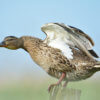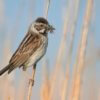REED BUNTING, EMBERIZA SCHOENICLUS, POTRZOS
- Aperture: ƒ/6.3
- Camera: NIKON D5200
- Focal length: 600mm
- ISO: 500
- Shutter speed: 1/2000s
[insert_php] if(function_exists(‘spr_show_rating’)){echo spr_show_rating();} [/insert_php]
The common reed bunting – Emberiza schoeniclus is a passerine bird in the bunting family Emberizidae, a group now separated by most modern authors from the finches, Fringillidae. The genus name Emberiza is from Old German Embritz, a bunting. The specific schoeniclus is from Ancient Greek skhoiniklos, a now unknown waterside bird.
It breeds across Europe and much of temperate and northern Asia. Most birds migrate south in winter, but those in the milder south and west of the range are resident. It is common in reedbeds and also breeds in drier open areas such as moorland and cultivation. For example, it is a component of the purple moor grass and rush pastures, a type of Biodiversity Action Plan habitat in the UK. It occurs on poorly drained neutral and acidic soils of the lowlands and upland fringe.
The common reed bunting is a medium-sized bird, 13.5–15.5 cm long, with a small but sturdy seed-eater’s bill. The male has a black head and throat, white neck collar and underparts, and a heavily streaked brown back. The female is much duller, with a streaked brown head, and is more streaked below.
Its natural food consists of insects when feeding young, and otherwise seeds. The nest is in a bush or reed tussock. 4–7 eggs are laid, which show the hair-like markings characteristic of those of buntings.
Source: Wikipedia
The photo is in JPG and uncompressed TIFF files. For printing, I reccommend the TIFF file.
I would be grateful if you could provide me with the information about how you used my work. If possible, send me pictures of that use.
You can download all photos for free as long as you provide appropriate credit.
They are licensed under the Creative Commons License.
You can read about the details on the Creative Commons official website.
This work is licensed under a Creative Commons Attribution 4.0 International License.





Leave a Reply
Want to join the discussion?Feel free to contribute!